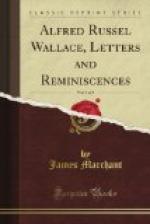[53] “The Geographical Distribution and Variability of the Malayan Papilionidae,” Linn. Soc. Trans., xxv.
[54] The passage referred to in this letter as needing farther explanation is the following: “The last six cases of mimicry are especially instructive, because they seem to indicate one of the processes by which dimorphic forms have been produced. When, as in these cases, one sex differs much from the other, and varies greatly itself, it may be that individual variations will occasionally occur, having a distant resemblance to groups which are the objects of mimicry, and which it is therefore advantageous to resemble. Such a variety will have a better chance of preservation; the individuals possessing it will be multiplied; and their accidental likeness to the favoured group will be rendered permanent by hereditary transmission, and each successive variation which increases the resemblance being preserved, and all variation departing from the favoured type having less chance of preservation, there will in time result those singular cases of two or more isolated and fixed forms bound together by that intimate relationship which constitutes them the sexes of a single species. The reason why the females are more subject to this kind of modification than the males is probably that their slower flight when laden with eggs, and their exposure to attack while in the act of depositing their eggs upon leaves, render it especially advantageous for them to have additional protection. This they at once obtain by acquiring a resemblance to other species which, from whatever cause, enjoy a comparative immunity from persecution.”
[55] This no doubt refers to Janet’s “Materialisme Contemporain.”
[56] Quarterly Journal of Science, January 7, 1867. “Ice Marks in North Wales,” by A.R. Wallace.
[57] I.e., the suggestion that conspicuous caterpillars or perfect insects (e.g. white butterflies) which are distasteful to birds are protected by being easily recognised and avoided.
[58] A bearded woman having an irregular double set of teeth. See “Animals and Plants,” ii. 328.
[59] The letter to which this is a reply is missing. It evidently refers to Wallace’s belief in the paramount importance of protection in the evolution of colour. See also Darwin’s letter of February 26, 1867.
[60] Menura superba. See “The Descent of Man” (1901), p. 687. Rhynchaea, mentioned on p. 184, is discussed in the “Descent,” p. 727. The female is more brightly coloured than the male and has a convoluted trachea, elsewhere a masculine character. There seems some reason to suppose that “the male undertakes the duty of incubation.”
[61] Westminster Review, July, 1867.




